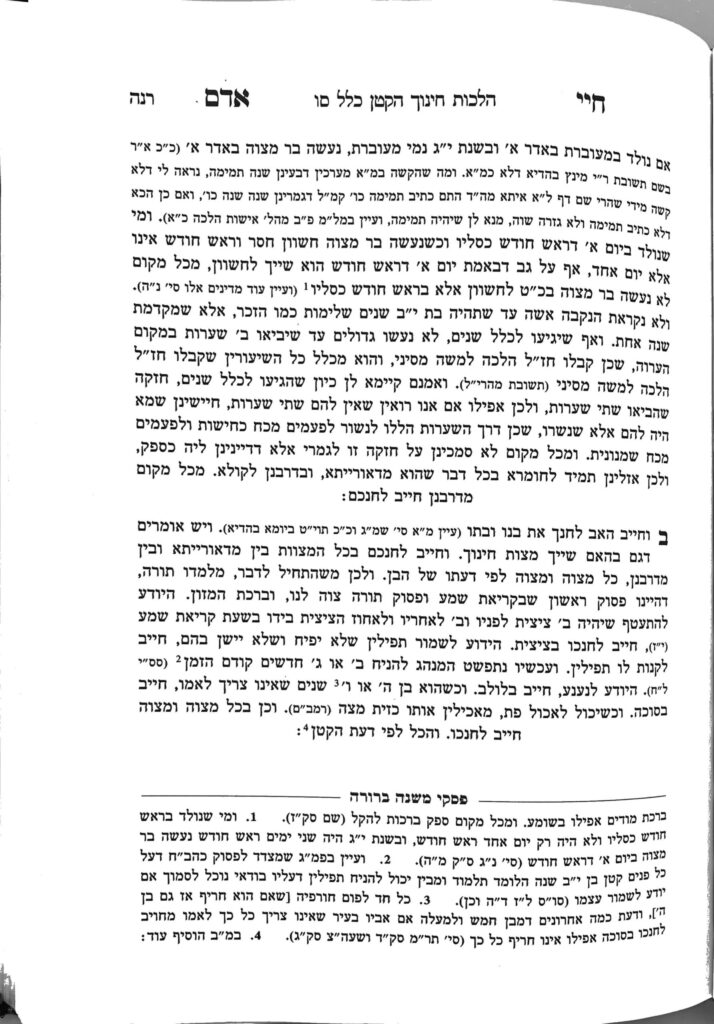We have finished siman 2, in which the Chayei Adam listed some examples of the proper age to begin chinuch in specific mitzvos. The Chayei Adam wrote that the correct time for a child to begin shaking lulav is when he is able to follow the procedures of na’a’nuim and kiskus. Today, we will discuss this mitzvah.
In discussing the chiyuv chinuch for a katan regarding lulav, the Shulchan Aruch uses a different language than that of the Chayei Adam. In siman 657, the Shulchan Aruch writes that once a child is able to follow the procedures of na’a’nuim, a father should buy a lulav for him. The Chayei Adam did not require the father to purchase the child a separate lulav, only that he teaches him how to use it. The Mishnah Berurah brings from the Maharshal that the father does not need to buy the child his own lulav, but the father can give his own lulav to the child after he is done with it. However, the Mishnah Berurah continues that if possible, it is preferable to purchase a separate lulav for the child, so he can perform na’a’nuim during hallel with the rest of the tzibbur.
We know na’a’nuim are not meakev; yet, nevertheless, the Shulchan Aruch requires, and Mishnah Berurah prefers, that one buy a child their own lulav in order to perform them. Thus, we see again that the mitzvah of chinuch is not just to enable the child to perform the mitzvah in a bedieved manner, but to train the child to perform the mitzvah in the correct manner; in the way they will perform it when they are an adult. However, the Biur Halacha makes it clear that in this case, it is not a chiyuv, but the preferred method of chinuch.
It is clear that the lulav and esrog given to the child cannot be pasul, as that would be training the child inappropriately for when they become an adult. Regarding the chiyuv of lochem, that the child should own the lulav, which is a chiyuv on the first day of Sukkos (and all seven days in the Beis Hamikdash), the Mishnah Berurah quoted above does not seem to require ownership.
However, in siman 658, where the Mishnah Berurah discusses ownership, he discusses the concept of matanah al menas lechachzir, that if one lends their lulav to another to fulfil the mitzvah, they must do so in a way which ensures that the recipient has complete ownership of the lulav for the during of their performance of the mitzvah. The Mishnah Berurah points out that this arrangement does not work with a katan, because a katan can accept ownership of an item, but does not have the halachic ability to relinquish ownership of it. In Eretz Yisroel, since the requirement of lochem is only for one day, a family could wait to give the lulav to a koton until they have all used it, and borrow it from the katan for the remaining days of Sukkos. However, in chutz la’aretz, lochem is required for the first two days, so if one were to give their lulav to a katan on the first day, they would not fulfil their mitzvah on the second day. Thus, in chutz la’aretz, the only option would be for the katan to borrow it. We need to clarify whether borrowing would work for chinuch or not, which we will clarify tomorrow, be’ezras Hashem.
Summary
Regarding the chiyuv chinuch for the mitzvah of lulav, it is preferable, lechatchilla, that the katan have their own lulav, in order to perform the na’a’nuim during hallel with the rest of the tzibbur.



